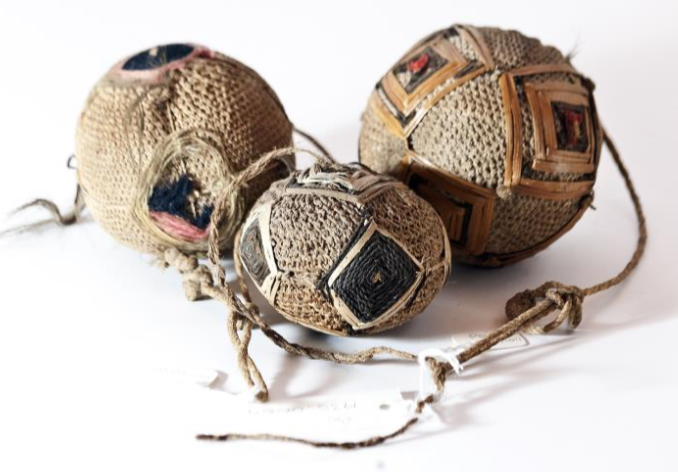poi awe
site link : https://collections.tepapa.govt.nz/object/65427
name : poi awe
production : unknown , weaver , 19th century , new zealand
classification : poi
materials : muka (fibre
material summary : muka (flax fibre , tahuna , dog hair, kiekie, raupō (bulrush , pīngao (golden sand sedge , wool
techniques : wrap twining
dimensions : 102mm (width , 82mm (height , 133.7g (weight
registration number : me000150
credit line : acquisition history unknown
overview : A poi is a light, circular ball attached to a cord that is twirled with the twist of the wrists in combinations of movements, around and against the hands and body. This example is a very rare type woven in muka (flax fibre) with a technique called knotless netting. It is called a poi awe, due to the presence of the dog-hair awe (tassles) attached as decoration. Poi are used as visual and rhythmic accompaniments to Māori cultural song and dance performances. Performersmight use a single poi or a pair,with either short or long cordage lengths.Traditionally, dried raupō (bullrush) leaves were used as the ball covering, with braided muka for the cords. Today, synthetic materials are used.
description : This is a Poi Awe Muka, inspired by the beautiful Poi Awe at Te Papa. The body is a knotless netting technique made from muka (flax fibre), the packing is tāhuna from raupō (bullrush flower seeds), and kiekie makes up the diamond papakirango pattern.
poi whakapapa : ( ?
- The Poi has its own whakapapa, which can be traced to Tānemahuta, the ancestral god of the forests and all things living in it. Tānemahuta mated with Hineiterepo (the swamp maiden) and they produced raupō (bulrush). Tānemahuta also mated with Pakoti (Pakoki) and created a superior species of harakeke (flax).
significance of poi in maori : ( https://www.mtghawkesbay.com
- The Poi dance was originally used by the Māori women for keeping their hands flexible for weaving and by the men for strength and coordination required during battle. Poi are also used as a training aid for other ancient weapons like the Mere or Pātū.
waiata poi : ( https://maoridictionary.co.nz
- (noun) song performed with a poi – modern songs are usually set to European-type tunes. Nā ēnei kōtiro te mahi waiata poi, waiata ā-ringa hoki hei mahi moni mō te kaupapa o Rātana (TTR 1998:113). / These young women performed poi songs and action songs to raise money for the Rātana movement.
can men do poi ? : ( .
- The current Te Matatini champions, Te Whānau a-Apanui, are widely known for their catchy tunes and original ideas. The use of the poi, performed by their men and women, secured them first place in this discipline several years ago.
why is poi important to maori ? ( .
- The Poi was used, many years ago, by the indigenous Māori people of New Zealand to increase their flexibility and strength in their hands and arms as well as improving coordination.
what is poi in spirituality ? ( .
- As poi Māori exponent Ngāmoni Huata explains, “Poi embodies whakapapa and the connection to the land and continuity of the culture through growth, hence the spiritual existence of poi is rooted in the beginnings of time.”

